An Old Aysle To Run Down 1

Amazon has just two (second-hand) copies of the Sourcebook left. But that’s still more than I found on eBay.
Preliminaries / Introduction: Why you should read this article
One of the good aspects of packing everything is that you discover where you had hidden away things that have been archived for long enough that those hiding places had been forgotten.
So it is that I h\ave found a whole bunch of material from my old TORG campaign, which I intend to use through 2024 as the foundation of various articles.
I’m doing this for a number of reasons, which collectively spell out why it’s worth your time to read them (some more than others, I must admit).
1. I can (almost) cut an article off in mid-sentence if I have to – so these will be flexible in an uncertain publishing period.
2. The Aysle material constitutes an excellent demonstration of campaign creation and world-building.
3. Aysle is utterly unlike any D&D world that I know of, and my variant on that is even more so. File off a few serial numbers, change a few names, and you have a unique adventuring environment to either visit or reside in for the duration of a campaign.
- The Orrorsh material is a lot scarier than the published, official, version – to such an extent that none of the PCs wanted to go there. They had one small taste of it (a freighter adrift at sea) and that was more than enough for them, thank you very much.
- A lot of people found the spell construction system to be confusing. So did I, at first – but once I understood it, I thought it was brilliant. Of course, I tweaked it a little, and – hopefully – explained it a lot more clearly than West End Games did at the time. Again, as house rules go, this is an interesting and robust one for GMs to contemplate.
- Finally, I’ve got a LOT of material that I can reconstitute or recycle, and if I don’t do this with it, it will never see the light of day. The campaign itself, though officially on hiatus, is unlikely to ever restart – not enough time, not enough interest, and I’ve lost touch with most of the old players. But it may be of benefit/interest to other GMs out there – whether they run TORG or not.
I know that I’ve mentioned the TORG campaign, and specifically Aysle, on a number of past occasions.
Part 3 of the Plunging Into Game Physics series, Tales from the Ether used it as an example, for example. And I described the Campaign as it turned out in play in Part 2 of my biographical double-post, Dice And Life: Bio of a gamemaster, which I posted to commemorate the 5th anniversary of Campaign Mastery.
This isn’t going to be like those occasions; instead of working from memory, I have my actual campaign construction notes for reference, including some forgotten goodies that the players never figured out / discovered.
But I thought I should point out why it is that some of this material might sound familiar to long-time readers.
The Campaign Concept
I’m not going to go into this in too much depth – there’s more than enough content in this category alone to be a post in it’s own right at some future point.
But there are some fundamentally important points to emerge from the process and those are worth highlighting, especially since they impact the main subject of today’s discussion – they explain why this was the starting point.
A Complex Reality
There’s a LOT of material for new TORG players to assimilate. Heck, there’s a lot for GMs to assimilate!
.
This requires massive information dumps or homework assignments that would turn most players and GMs off. I know at least two players/GMs who bought the system and then packed it away as too much like hard work – I know, because I ended up buying stuff from them, second-hand. No, make that four – Graham, Adrian, Stephen,.and Ian. Two of them became players in the campaign when I ran it.
There are six or seven realities, the overarching Infiniverse, the basic rules, the reality-changing rules, the history, and so on. Each reality has its own unique character options and capabilities and rules structures, but characters from the other realities or Cosms can go there and interact with the locals..
From just about day one, I wanted to break all this up into manageable pieces.
The foundations of a plan
So I started working on a way to achieve this.
I picked Aysle as my starting point because the fantasy Cosm would be closest to something familiar to the players.
Phase 1
I deliberately intended to start the campaign prior to the Possibility Wars (which involve those reality-changing rules that I mentioned) so that players could get familiar with the basic game system. ONE reality, ONE set of rules.
They would have an epic adventure (multiple game sessions), from which they would return to discover that the bad guys were now in charge, that a bridge had been opened to a new Reality called Earth, and that a war of conquest was underway.
Since the only hope of freeing their homelands from the forces of Evil was the leader of the resistance (who had been lord high muckamuck when they left), and She was on Earth. So they would have to follow.
Phase 2
That introduces the more complex reality and the basics of the Reality Changing rules, but it keeps them in the Earth-contaminated adjunct to the Fantasy Realm while they get used to them.
A couple of short adventures and (I’m a little fuzzy on this point) they would be sent out to recruit allies in every Realm. The Bad Guys were basically an Oligarchy who had each other’s backs much of the time (even while they plotted and back-stabbed each other). Unless they all faced a crisis at the same time, they possessed overwhelming force.
Which would lead to:
Phases 3+
The PCs would make their way from one Reality to another using available means of transport. Each time they entered a new reality, one player was required to generate a character from that Reality and then choose to stick with what they had or ‘trade them in’ for the newcomer, retaining all earned XP. If a player wanted to volunteer, that was fine, if a new player wanted to join the campaign, that was also acceptable.
That was justified on the basis that each of the ‘new’ characters would have been having adventures of their own before being tapped to join the party. They each had to have their own motivations for doing so, ones that made sense under the “rules” of the Reality that they came from.
One Reality at a time, they would gain a basic understanding of how that Reality worked and the party would slowly metamorphose from a straight fantasy party into something more cosmopolitan.
The last Cosm to be visited was to be Orrorsh, the Horror realm, but the campaign ended before they got that far.
Phase X
I forget how many Realities there were to visit, but Orrorsh was to be the last of them, as I mentioned, and it was to provide the lead-in to the epic conclusion of the campaign, in which The Gaunt Man makes a power-play to seize control of ALL the Cosms and a darker, more sinister plan that had been underway throughout the Possibility Wars was revealed.
The PCs couldn’t save everyone, everywhere – they would have to pick and choose and have a strategy to overcome this threat. It would not happen cheaply, there would be a steep cost involved, but they could win – there were six or seven paths to victory, one for each of the Cosms, but they were mutually contradictory.
Each one required making alliances and having some of those allies not make it out the other side. (The Living Land was usually a casualty, for example).
Realities would change, whole populations would die or be saved, and it would take about half as long as the entirety of Phases 2-to-whatever.
That was the basic plan – a foundation and then add bricks one at a time until the house began to take shape.
Aysle: Fantasy Cosm
From word one, there were elements of Aysle that were hard to get your head around.
The basic world was a pie plate – actually, two very dented pie-plates, base- to-base, with a hole in the middle, through which the sun transited each day – rising at Dawn and setting at Dusk.
Right away, I had questions:
- How big a Hole?
- How big a sun?
- Which way was down?
- What stopped all the water from falling down the hole?
- How did you get from one side to the other?
- Mountains? Tectonic Activity?
- Conditions near the center?
- Conditions near the edge?
- Seasons? How
- Weather?
- Sailing ships – Trade Routes? Favorable Winds?
And all that was before I got to the more complicated questions of who lived where, and politics, and borders, and ecologies, and trade goods, and money, and so on (I’ll cover at least some of those in #2 in this series).
Having generated this long list of questions, I set about answering them, one by one.
The Hole In The Middle Of The World
There’s no scale on the maps of the Cosm provided in the sourcebook.
The sun is 93,000,000 miles from earth. If the hole is that big then the maps make no sense – the ‘planetary’ surface would extend out more than 14 AU, clear out to the orbit of Saturn and well beyond.
Okay, so no 93 million miles. That means that the sun has to be a lot smaller and weaker than our sun.
Using The Map
In the text, it describes the world as being about 9000 km radius. The map measures out as 17cm across, near enough. So, not quite 1 cm to the 1000 km, but not far off it – 9/8.5 = 18/17.
The hole has a diameter on the map of 1.2cm. Assuming it’s to scale, that’s a diameter of 18 / 17 × 1.2 = 21.617 thousand kilometers, or about 1250 km. Again, near enough.
The Size Of The Sun?
So, how big is the sun? Radius 9000, and the temperate regions are about 1/2 out, so distance 4500km. The sun goes up into the sky a certain height and then comes down again. (Why? Get to that later).
Advice:
Never be afraid to at least stick your nose down a rabbit hole, you never know when what you find will come in handy!
Angles. At the very edge of the hole, the sun would be virtually overhead. The further away from that center point, the greater the angle at the sun’s highest point.
Insert a stick in the ground, measure the angle at noon, and you would always know your longitude-equivalent.
So let’s look at some Trig.
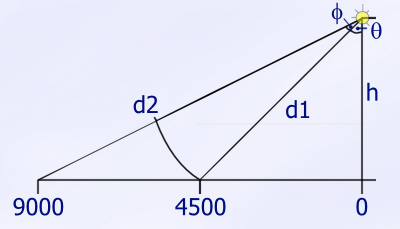
Aysle Solar Trigonometry
I’ll work the problem using three different values for h and see what I get.
H = 4500 km:
tan (theta) = 1
Theta = 45°
tan (theta + omicron) = 2
Theta + Omicron = ~64°
Omicron = ~14°
d1 = 6364 km
d2 = 10062 km
100 x (d1/d2)^2 = 40%
h = 9000km
tan (theta) = 2
Theta = ~64°
tan (theta + omicron) = 4
Theta + Omicron = ~76°
Omicron = ~12°
d1 = 10062 km
d2 = 12728 km
100 x (d1/d2)^2 = 62.5%
h = 18 000km
tan (theta) = 4
Theta = ~76°
tan (theta + omicron) = 8
Theta + Omicron = ~82.8°
Omicron = ~8°
d1 = 18554 km
d2 = 20125 km
100 x (d1/d2)^2 = 96%
Those last numbers apply the inverse-square law to determine how much less light and heat the edge receives compared to the temperate zone.
So if I can determine how much less heat/light the earth gets at the arctic circle relative to the midpoint of the temperate zone, I can work backwards to get the actual height above the surface.
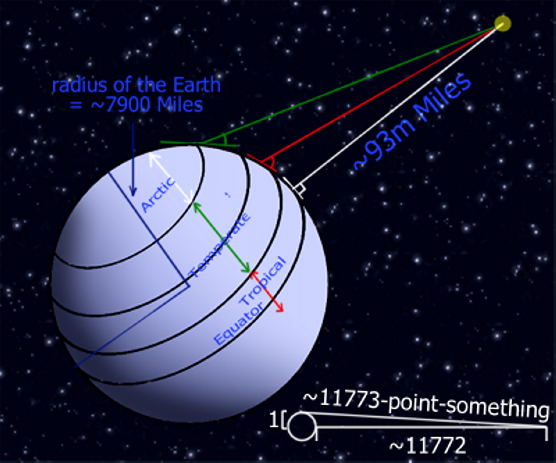
.
Terrestrial Solar Trig
First of all, the sun is so far away that we can forget the inverse-square law. The triangle at the bottom of the page makes that very clear – a one in 11772 squared difference is essentially no difference at all.
What matters on a globe is the angle of the sun to the normal of that point on the globe. The normal is always perpendicular to the tangent, so that’s the starting point. I’ll ignore axial tilt for a moment.
At the equator, the tangent is at 90° to the sun, and so the normal points straight at the sun – a perfect right angle and they get the maximum amount of sun that it’s possible to get.
At the poles, the tangent is on a plane that includes the sun (effectively), an angle of 0°. The normal is therefore at right angles to the sun.
So, ten degrees north of the equator , the tangent will have rotated 10°, and therefore so will the normal – from 90° to 80°.
The arctic circle is at latitude 66°34′ N – call it 66.5° for convenience – and the tropics start at latitude 23.5°N and extend to 23.5°S, so midway between them is latitude 45°.
When you look at the diagram below, that’s suddenly not as surprising.
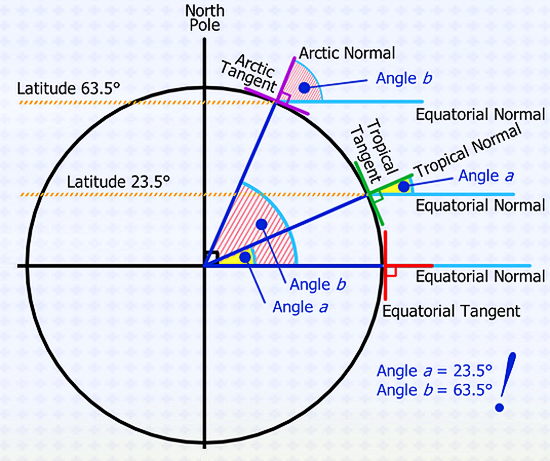
It’s actually simpler than it looks.
But there is a lot going on here, so take your time and look it over carefully.
I’ve shown three tangents and their associated normals – which happen to align perfectly with the angle relative to the equator, which just happens to define latitudes. The three chosen are the equator, the Tropic Of Cancer, and the Arctic Circle.
The power of parallel lines makes it clear that the angles I’m interested in are the angles defined as the latitude. In fact, if I extend the tangents until they meet the equatorial normal, I get a right-angled triangle.
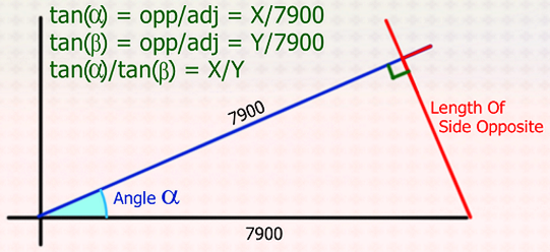
(This was originally part of the above diagram, but I wanted to keep the illustration and the text together)
What we’re interested in is the length of the opposite side to the angle. I could have used tan or sin functions but tangent is more traditional.
Actually, what I really care about is the ratio of those lengths, because that (squared) gives the relative amount of sunlight and heat falling on a given area. I don’t actually care about X or Y, I care about the ratio of the two.
So, tropics: vs temperate: 23.5° & 45° respectively; tan(23.5)° = 0.4348; tan(45°)=1. The temperate zones get 43.48% as much heat and light as the tropics.
Arctic vs temperate: 63.5° & 45° respectively; tan(45) is still 1, tan(63.5°) = 2.0057, so the temperate regions get 2.0057 times as much heat and light as a spot on the Arctic circle.
(Actually I think those numbers should be squared – we’re talking area on the surface of a globe, it bends away in both directions, horizontally as well as vertically. So that’s 18.9% and 4.022 times, respectively.
The Earth’s Orbital Ellipse
There are an astonishing number of people who think that the reason we have seasons is because the Earth’s orbit is an ellipse, meaning at one end of it’s annual trip around the sun, it is closer to it.
The ratio between the long axis of an ellipse and the short axis gives the eccentricity of that ellipse (subtract the ratio from 1). The closer to 0, the closer to a circle the ellipse is.
The eccentricity of Earth’s orbit: 0.017. An ellipse twice as long as it is wide has an eccentricity of 0.5, which is to say it’s 29.4 times more extreme.
I’m not saying it would have no effect; just that it would be trivial.
The axial tilt
To anyone who knows anything of the Astronomical specifications of Earth, the number that has probably leapt out at you (if you didn’t know this already) is 23.5°.
This just happens to be the Axial Tilt of the earth’s rotation, and that has a big impact.
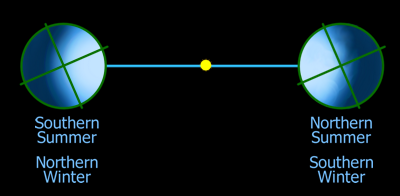
.
Let’s call the amount of sunlight received at the Spring and Autumn equinoxes, when both hemispheres receive the same, 1.
Then tan(23.5°) = 0.4348 – so, in winter, hemisphere 1 gets 43.48% as much heat and light; and in summer, they get 1/0.4348 = 2.3 times as much as our ‘standard’ unit. Or are those numbers squared, since we’re talking about areas and globes? I think so – giving 18.905% and 5.29 times, respectively.
Either way, that’s such a huge differential that it far more than swamps the pittance from orbital eccentricity.
Back To Aysle
But, at this point, I decided that I’d looked deeply enough down this rabbit hole; the h=9000 numbers weren’t perfect but they were close enough to the target that I didn’t want to spend any more time on the question.
It didn’t particularly matter what the actual numbers were, anyway; it was enough that there was a solution, one based on using the inverse-square law and a much smaller baseline instead of the angles of a globe. Time to move on.
Let’s Talk About Up and Down
Gravity, says the sourcebook, is always perpendicular to the plane of the world’s surface.
Okay, so we can assume that the sun is small enough that it has no significant gravitational effect.
Mass makes gravity. Aysle is about 1000km thick according to the sourcebook. That’s not enough to make a significant amount of gravity.
Let’s be generous: 9000km radius = an area of 254,469,005 square km. 1000 km thick = a volume of 254,469,005,000 cubic km. Volume of a sphere = 4 / 3 pi r^3, so this is the same volume as a sphere 3931.1121 km radius.
A cubic foot of rock weighs, on average,165.2 pounds. There are 3.531e+10 cubic feet in a cubic km, so our sphere would weigh 1,484,371,653,594,060,000,000,000 lb, which works out to 6.733e+20 tonnes.
Earth weighs 5.972e+21 tonnes, so this is 11.2743% of the earth’s mass.
Surface Gravity should therefore be 0.112743G.
To get anywhere close to 1G, something other than mass has to be making around 89% of the gravity.
Assuming it’s evenly distributed, that would be close enough to a vertical orientation – at worst, there might be a deviation of 7.24%, and that would be right at the outer rim. In the temperate zones, it would be half of that.
For that matter, it doesn’t actually need to be evenly distributed – it could be concentrated under the temperate areas, or where there are mountains.
What is it? Another question to get back to.
Why does the sun rise and fall?
Another gravity-related question, at first glance.
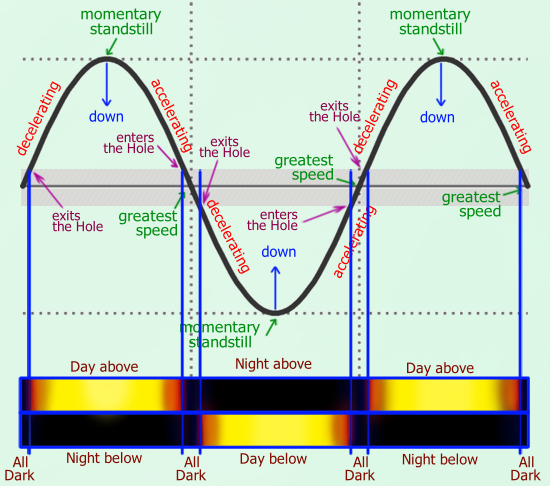
The sine wave image on which this illustration is based was provided by hiclipart.com
Except there isn’t enough gravity to make this happen quickly, i.e. on a daily basis. Unless, of course, whatever it is that’s supplementing gravity also acts on the sun, which – logically – it should.
But some seat-of-the-pants back-of-an-envelope calculations said that there were more problems. Either it all happened too quickly, by far, or the periods of “All Dark” would be excessively long..
On earth, the perception is that the sun tends to hang on for two-to-three hours at or near the zenith of it’s daily ascent into the heavens, having ascended at a more-or-less constant rate each hour and then falling in a similar fashion. In summer, both rates are slower but persist for longer – more sunlight hours are the result.
This is what I was aiming for:
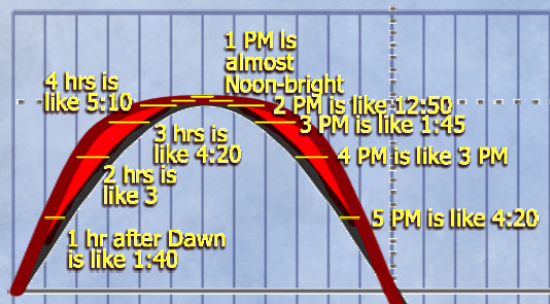
.
It might not seem like much, but I was still concerned with the sun being so much smaller, and whether or not it would deliver enough energy to support a rich ecosphere. In a nutshell, I wanted lots of plant life which could feed lots of animal life which could make life interesting for the PCs.
Add that to the parameters of the “what makes Gravity” unresolved question, then. I need there to be progressively less Gravity as the day reaches its midpoint.
What stops all the water from falling down the hole?
Mountains, obviously – some sort of rim.
Not according to the sourcebook.
So, gravity can’t be uniformly perpendicular at all – strange things happen as you approach the hole, and gravity begins pulling you back toward the tropical regions. And the closer you get to the hole, the stronger this effect. In effect, even though the terrain is flat, the hole is always “uphill”.
This makes a lot more sense if the “Gravity-X” is from a layer in the middle rather than distributed throughout.
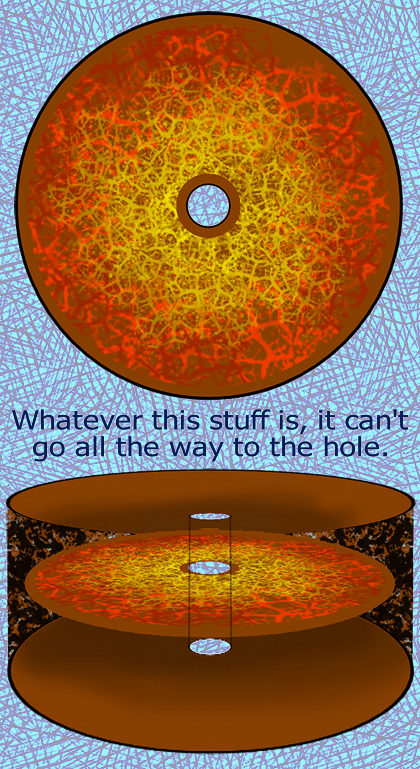
It’s a little bit cleaner and clearer, but this is still remarkably similar to my original concept sketch. Note that the colors of the “gravity stuff” get brighter as they approach the center; I didn’t know why I did it that way, but my subconscious must have been feeding me clues!
Under this arrangement, the oceans form a continuous band around the edges of the “hole”, perhaps a bit shallower because the gravity (both natural and from “substance X” is at it’s greatest at the exact mid-point of the disk.
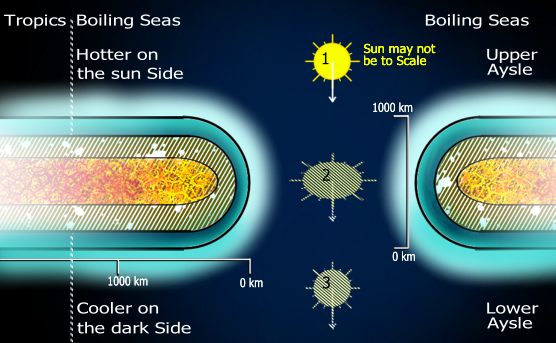
This image shows three things. (1) A cross-section of the central parts of Aysle – the hole, the gravity stuff, and what it does to the oceans; (2) the effect the gravity stuff would have on the sun during passage, stretching it and then letting it go back into shape, re-energizing it; and (3) the impact on ocean temperatures, which more-or-less matches what’s in the Sourcebook.
What Makes Gravity if it isn’t mass? And, if it’s variable, with what does it vary?
So this stuff makes Gravity, i.e. adds extra mass, under some conditions yet to be identified, but that get triggered by the approach and passage of the sun. And it’s deep underground.
The sourcebook says that Dwarves and other races live underground, and that Dwarves are an inventive lot in this reality. Miners and Engineers and the like.
It would be inevitable that they would discover this material and its unique properties, and find some way to take advantage of it. And if that conferred some military advantage, they would impress upon their entire population the need to keep it a secret.
They would also name it. I settled on “Down”, a name that is entirely appropriate to something discovered in ancient times when words were simpler, and a name that would create a false impression if mention of it were ever to escape, since that is also the name for goose feathers and the like.
How does it work?
I felt I needed some explanation, even if it was entirely incorrect, that represented the best guess of the Dwarves as to how this stuff made additional mass.
The theory was that the mass is always there, but pointed in a direction that people don’t experience or perceive. Whatever causes the transition reorients the ‘spin’ of down-particles in the electron soup so that the sense of mass transitions into our world and not this other-world. Only when the Aether is properly polarized through the Down does the true mass (or part thereof) get felt.
This takes some of the basic ideas of quantum mechanics and mixes them up with early atomic models that were more-or-less appropriate for the technology of the era (blunderbusses and early black powder weapons) to assemble a Frankenstein’s Monster of semi-plausible theory.
(These days, I’m reminded of a couple of lines from one of Edding’s Books. One of the (supporting) characters has just offered up a rather specious theological argument, leading another to respond “You’re on very shaky ground” – or words to that effect – to which the reply is, “I know, that’s why you have to run so fast to get across it.”)
Even Distribution – Isn’t So Even
The surface of Aysle, like the surface of most worlds, isn’t smooth. It’s quite lumpy, in fact. Ordinarily, that variability is a tiny fraction of the horizontal distances involved, so the topology looks pretty flat when everything’s in scale, But Aysle is only 9000km in radius, and some of that is Hole.
What’s more, the notion that everything is Larger-Than-Life in a Heroic setting says that whatever Earth has, Aysle has more of, be it huge mountains or deep, deep ocean trenches. Those might just be enough to be visible even to scale.
Mount Everest rises to 8,848.86 m (29,031.7 ft) – that’s 8.85km. But that’s nothing. Olympus Mons on Mars is over 21.9 km (13.6 mi or 72,000 ft) high. And Mars is much smaller than Earth – 3,389.5 km vs 12713.82 km (7900 miles). Olympus Mons scaled to a globe the size of Earth would be 3.75 × 21.9 = 82.125 km. Now THAT’S a mountain to respect!
The Deepest part of the ocean is the Mariana Trench, which falls to a depth of 10,994m – call it 11km. Again, though, Mars has us beat hollow (once we scale it) – Melas Chasma is the deepest trench on the red planet, at 9km deep. Scaled to Earth Size, that’s 3.75 x 9 = 33.75 km.
Put the two together, and you get an altitude differential of 115.875 km (72.001 miles).
If the average thickness of Aysle is about 1000 km, as specified, that’s 11.6%. More than enough to show up at scale!
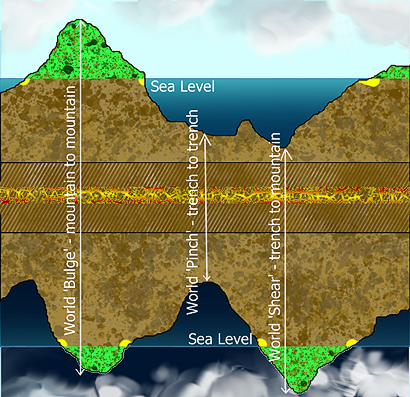
I thought about showing what 11.6% looked like, but decided instead to show something more important – Bulge, Pinch, and Shear. Heights are definitely not to scale!
The Variability
There are only three things that would change with the approach of the sun. 1. More Heat; 2. More Light; 3. Tidal Stress. Which of these was going to be the factor that activated the increased gravity?
I was already using tidal stress to ‘rev up’ the sun, and I’d prefer not using that for two different things. Rule it out, at least temporarily.
I had problems seeing a 9,000 mile network of mineral veins of some kind carrying light, and it comes and goes so quickly – literally at the speed of light – that it seemed too abrupt a trigger. But I did lift the ‘veins of Crystal’ idea for lighting Dwarven communities – over much shorter distances.
That leaves heat, at least notionally. What clinched the deal was that I immediately saw how Dwarves would capitalize on Down to make themselves even more impressive – and recruitable (for a smallish fee, of course – not all Dwarves are Mercenary, some are merely Greedy. There are even a few altruistic black sheep!)
Absolutely yes to both. “Down” needs to be a very efficient conductor of heat if it’s to serve it’s purpose of supplementing gravity all over the disk – perhaps slow to heat up in the first place but retaining it’s heat for some time. It would have to be better at channeling that heat along its veins than most metals – perhaps even a high-temperature superconductor (my players never figured that out, they could have made a fortune selling Down to the Cyberpapacy or Nippon Tech!)
The heat of the sun makes the oceans boil, close to the hole; that’s canon, from the sourcebook. That heats the land beneath the surface, which might also be molten as a result, which makes a LOT of gravity in the closest Down – which then dissipates that heat throughout the rest of the disk, like a giant heat-sink.
Many, many years ago, I visited an Aunt who had just had underfloor heating installed. This is the same idea, really.
Seasons? How
Right now, there’s nothing in place to generate seasons. Heck, there are only solar tides – and the effect of Down would tend to dampen those. Unless the sun also had a core of Down, perhaps.
I seriously considered whether or not to make Aysle a one-season-all-year-long environment, but decided against it for a couple of very good reasons.
Reasons To Have Seasons
First, seasonal variation is necessary to too many varieties of plant life. I wanted high biodiversity, and this seemed a retrograde step in the opposite direction of that.
Second, while the scale of the impact is debated in some circles, I was firmly convinced that the Day/Night – Lunar/Month – Seasons/Year cycles were absolutely essential to man’s intellectual development. Observing patterns and making rational deductions about the causes, and how to take advantage of the regularity of them, was one of the keys to development of civilization, in my view. With no moons, those cycles were already under stress in Aysle; take away the seasons and the plausibility became extremely doubtful.
Third, I was also still deeply concerned about the stability of the whole system. Any serous perturbation of the up-and-down solar orbit and eventually, the sun would hit the inside of the Hole. Something acting to create the seasons could be a stabilizing influence.
Fourth, a setting for Epic Fantasy Adventure demands an epic environment, and part of that is Winter on an Epic Scale. There’s too much fantasy iconography that demands a world covered in a mantle of white.
Fifth, the sourcebook talks about wobble. Okay, some sort of Wobble, if it’s regular enough, could cause seasons. But what causes the wobble, and why does it not destabilize the ‘orbital’ system?
And, finally, some sort of Wobble-and-season-inducing phenomenon could provide a supplemental addition to the list of places to Adventure.
Back to the previous question – How?
I eventually nutted out a solution in three parts, then added a fourth.
Uneven Distribution Of Down
Th first part lay in discarding an assumption that didn’t bear merit on closer examination – that Down was evenly distributed.
The more I thought about it, the more I realized that on a tectonically-active world, it couldn’t be – some of it would have to melt (and promptly coalesce into a spherical blob of some kind. It would then be carried, along with the other volcanic matter, to the scene of an eventual eruption, where it would act to decrease lava flow, literally pulling it back into the mountain until sufficient pressure arose to overcome this additional resistance.
More Krakatoas, fewer Kalaueas (Hawaii); more Mt St Helens, less Grindavik (Iceland).
.
The implication was that at the heart of every major mountain, there was probably a central mass of cold Down.
That’s important because it means Dwarves don’t have to deal with the hot, gravity-creating veins of Down, they can settle beneath the big mountains and mine away at it to their hearts content.
At the time, my initial thought was that this would attract one side to the sun’s passage more than the other, causing Aysle to tilt that side toward the sun.
But then I realized that the solar cycle was Daily but what was needed was slower and longer-term, and that the edges – where I was proposing this discontinuity of Down – were an awfully long way away on the Aysle scale of things..Perhaps too far to have any significant impact.
That led me to Solution Part 2.
The Dark Companion
I needed a planetary body of some sort that, twice a year, made a relatively close approach to the edges of the disk. On one of those passes, it would be closer to the Down Mass, and would drag at it, creating the ‘wobble; on the other pass, it would be on the far side of Aysle,
I tried calculating the orbit of one body circling another, the latter having variable gravity, but the math was beyond me. Intellectually, though, I could frame the general concept – less gravity means that the object’s path is not slowed as much as you expect, so it goes further out, and takes longer to return. More gravity means that it gets accelerated more as it approached and slows more as it departs.
The amount of wobble imparted would therefore vary on the time of day it made it’s closest approach to the Down-cluster, and so would the interval between passes. The seasons would have a natural variability in length, but over many decades or centuries, a pattern would start to emerge. In particular, the sun’s position relative to both would be critical.
Sometimes, the combination would lead to less wobble, even dampening down the wobble already present; that would lead to temperate and stable climatic conditions for the next year. On other occasions, it would increase the wobble, leading to more extreme seasonal variations.
There was no mention of such a body in the Aysle Sourcebook because the residents had no idea that it was present. That mandated that it be a dark, unreflective body. It would be most visible as it came toward another close approach, and most visible close to the edge with the Down cluster – but these are arctic conditions, and few if any live there to observe the phenomenon.
From time to time, it would occlude one of the few visible stars in the Aysle sky – 12 ringing the Horizon, rising and falling with Wobble, 5 more visible only from Upper Aysle, and four visible only from Lower Aysle – but that could be anything passing in front of the star, from a Dragon to a cloud.
Some years, Lower Aysle would receive more sunshine, other years it would be Upper Aysle; some years it would be both, and some, neither. There’s a regularity, an order in that list.
Meta-seasons In Aysle
Specifically, I thought the pattern would run:
- Upper Aysle – good, Lower Aysle – bad
- Upper Aysle – okay, Lower Aysle – better
- Neither, but Upper Aysle better than Lower
- One okay, the other bad OR one okay, the other good
- One okay, the other better OR one so-so, the other good
- Both – good
- One okay, the other better OR one so-so, the other good (the opposite of 5)
- One okay, the other bad OR one okay, the other good (the opposite of 4)
- Neither
- Upper Aysle – worsening, Lower Aysle okay
- Upper Aysle – bad, Lower Aysle – worsening
- Both Bad
- Neither, but Upper Aysle worse than Lower
- Upper Aysle – improving but still bad, Lower Aysle Bad
…repeat.
Re-reading that list now, I’m not sure I still agree with it, or with the methodology behind it. It seems to be based on the combination of two cycles, one longer than the other, so that there are occasions when the two are both at low points (producing a ‘both bad’) and times when the two are both at high points (producing a both good).
Rating the weather from 1 to 4, one cycle would run:
4, 3.5, 3, 2, 1.5, 1, 1.5, 2, 2.5, 3 (10 entries)
…and the other would be
4, 3.5, 3, 2.5, 2, 1.5, 1, 2, 2.5, 3, 3.5 (11 entries).
That would result in a 110-entry combined cycle – and there aren’t 110 entries on the earlier list!
In reality, of course, these would be the midpoints of a range, and the score would be out of 5, not 4. And that probably means that I can dismiss those “x.5” entries on the lists:
3-5, 2-4, 1-3, 1-3, 2-4, 3-5 (6 entries)
…and the other would be
3-5, 2-5, 1-3, 2-5, (4 entries).
…yielding a 24-year cycle of seasons but with enough variability to keep it from being noticeable until statistics could be compiled.
But the broader pattern – good years followed by worsening years followed by bad years followed by improving years – that would be noticeable. It’s just that any given year could be better or worse than expected – and sometimes that would only be noticeable in summer, sometimes in winter, and sometimes most of the year around.
Sounds just like the real world, doesn’t it?
The Inverse-Quad Law
I didn’t want Ayslish Philosophers to be able to deduce the existence of Down from simple observations. That would eventually put them on a path toward science and not reinforce a self-sustaining Fantasy model.
To muddy the waters, I casually wondered if Down might not obey an inverse-cube law instead of inverse-square. In other words, part of the gravity was on one curve with distance and the other was on a different curve – but you couldn’t measure the two independently, only the total of both at the same time.
The more I thought about the repercussions, the more I liked the notion. I then took the concept one step further: Down attracting Down obeys the Inverse-Cube law; Down attracting non-Down obeys an Inverse-Quad law.
That meant that the atmosphere would thin faster as you ascended, but the holds on flying creatures would also be greatly reduced, permitting larger creatures to fly (actually, it would be a combination of flying and gliding). I wanted my Dragons!
The notion of having three different relationships, and sometimes only two of them being relevant, and all that you could measure was the compound effect? Good luck on figuring that out, which was the primary purpose.
Reinforcing The Premise: Origins of the Dark Companion
It was when I realized that the Dark Companion could have deposits of Down that were only active when tidal stress was at a maximum (i.e. close passage to Aysle) that I realized that this would both amplify the Wobble and act to keep the orbital patterns synchronized that this became the third piece in the puzzle of the seasons and where they came from.
The final nail in the assembly was realizing what the Dark Companion actually was: The material removed from the Hole to permit passage of the sun.
That meant that one one side of Aysle, there would have been mountains at the hole, but that they had broken down over the years. The oceans are boiling in that area, remember – who would have been around to witness their existence?
Part the fourth: The Bright Companion
It bothered me a lot that Aysle had no moons. Not only for the lessons in regularity that a moon provides, stirring the intellect of inhabitants from, but for the generation of tides, and for the sheer romance that it’s capable of bringing to society.
A bigger, brighter, planetary body ticked all of those boxes. No Down involved, so it could be made bigger to scale lunar and solar tides accordingly, and in a 30-day cycle that ‘just happened’ to mesh perfectly with the orbital ballet.
Dwarves are an inventive lot
If you were a Dwarf who had discovered Down and the basics of what it did, how would you harness it? I mentioned earlier that one of the reasons I fell in love with the idea was because a couple of ‘industrial’ applications came to mind almost immediately.
The Dwarvish Railroad Network
If you’re mining and constructing tunnels anyway, you’d put down some ore-cart tracks. If you then attach a lump of Down to a cradle at the front of the contraption and a clamp to hold a torch, the cart always runs downhill, even when climbing a slope.
Want to go faster? Throw some accelerant on the torch. Want to slow down or stop? Another piece of Down at the back (and the judicious application of a hand-held torch) – or a strong Dwarf with a pair of tongs picking up the Down and transferring it to a second cradle at the rear.
Expanding on that principle gave rise to the Dwarvish Underground Railroad (I love a good play on words!) These high-speed intercontinental (because the earth runs under the seas as well) transit systems would make it possible for a Dwarf – or a Dwarven Army – to be anywhere on Aysle in a couple of days.
Mobility at this level is a BIG military advantage. The secret could be preserved by telling surface dwellers that the army had run all day and all night for (several) days in a row to get there, but were all still as fresh as daisies after a nice afternoon kip. The myth of Dwarven Stamina is born – simultaneously marking these as Different from the Dwarves of other fantasy games and yet (superficially) bringing them closer to the Fantasy Cliche.
I couldn’t see the Dwarves being able to use this network for Cargo, not without risking the secret – but they would also use it to enable themselves to scrupulously adhere to delivery dates.
So overland haulage and vessel-based shipping were protected from the effects of this alternative, preserving some of the social flavor that the world should have. Done deal, right?
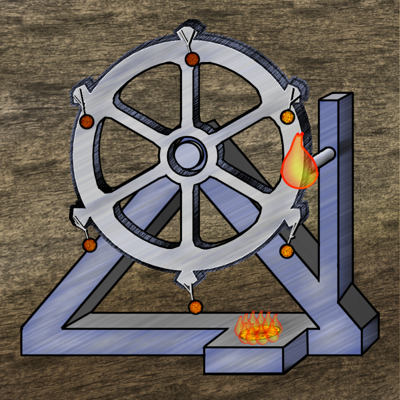
Dwarven Engines
Make a wheel out of metal and attach it to a hub via a metal axle. Spaced regularly around the edges are cages that hold pieces of Down. A strategically-placed torch heats one piece of Down at a time as the wheel turns. An additional piece of down is located at the base of the device with a source of heat, probably a liquid of some kind.
The Down on the wheel on the side that is getting heated attracts the down in the plate at the bottom much more strongly :
The Heated Down at the base of the platform attracts the heated Down on the right side of the engine MUCH more strongly than the cooling Down on the left and top. This forces the wheel to rotate, bringing another piece of Down into the heating range. It’s a basic variation on the water wheel. Put the whole thing in a box (with apertures for lighting/refueling the flames) and you have a Basic Dwarven Engine.
Attaching anything you like to the other side of the axle translates heat and gravity into mechanical work, enough to drive a borer, or a water-pump, or an air ventilation system – or a powered vehicle like a tank or horseless carriage (once you have the idea).
Dwarves never sell Dwarven Engines, but they will hire them out, with appropriately-skilled workforce, for whatever purpose someone will pay for. They are a “black box” to the rest of society, with the wheel turning as if by magic All work performed by Dwarven Engines is carried out under the strictest security – only Dwarves permitted on-site, armed guards, etc. They contract to do a job on an impossible schedule, then deliver on that promise – no questions asked means no lies told.
Occasionally they will be asked “how” anyway; the standard response is to flex their muscles and announce “Dwarven Engines”, implying manual labor at a frenetic pace that only a Dwarf could sustain.
Dwarves use them for everything from quarrying to stamping out “standard bricks”. Small ones drive rotisseries for the cooking of food on a spit.
Note that most of the Dwarven Population don’t know how they work, either. If anyone asks, they are told “Goose Magic!” with a laugh.
There’s one further refinement to the various “Goose” stories told by the Dwarves in more modern times – it’s become an in-joke to refer to the engines as “The Geese That Lay The Golden Eggs”.
Weather & Climatology
The oceans near the hole are usually boiling; late at night, they may be reduced to steaming. This pushes moist, wet air toward the tropical regions, where much of it falls as torrential rain. Local geography plays a key part in directing these air masses; some tall, narrow canyons can accelerate them to hurricane force.
The temperature in the tropical regions isn’t enough to make the oceans boil, but they still drive evaporation, which becomes rain and occasionally snow in the temperate regions, especially at Altitude. Weather just like Europe’s basically.
Not a lot of moisture makes to the Icy regions outward of the temperate zones, but what there is will typically fall as snow, sometimes even in summertime.
Past those regions lies the frigid outer rim. Sleet and snow are the best that can be hoped for in these regions, but the temperatures are such that what falls there tends to stay there, frozen, for quite a long time, building up into great icy mountains.
But there’s little Down in the Arctic regions, and a lot of tidal stresses from both the Bright Companion and its unsuspected dark brother. This occasionally causes whole mountainsides of ice to break off and drift inward, propelled by ocean currents deriving from the same source as the winds before being turned aside and forced back on themselves by the ice wall before them.
As these return currents approach warmer waters, they are forced under the surface layers, often losing cohesion in the process. Deep sea fishermen in the regions know, the current deep below can flow in any direction, and if you don’t like the one you’ve got, another lies just a few hundred meters away.
Stability concerns
I was still deeply concerned about the stability of the whole system; if you’re rotating, conservation of angular momentum helps keep you oriented and stable; without that, the slightest error could accumulate until it becomes overwhelming.
This bothered me for quite a long time, until I realized that when the sourcebook explained that Aysle was not rotating, and explained how the locals knew that, what they were saying didn’t happen was rotation relative to the stars. But if those stars were also rotating, along approximately the same axis, with virtually the same angular speed as Aysle, everything would match up.
Of course, assuming that the speed of light was still a traffic cop on reality, there would be a limit to the speed of that rotation. But it didn’t have to be a complete revolution in 24 hours; not if the stars were keeping pace.
How Big is The Universe?
So, 17 visible stars. Let’s assume that’s all there are, because that gives me something to work from.
Going to Wikipedia’s list of the 50 nearest stars, sort them by distance, and count down to the 17th that’s visible to the naked eye, it’s distance gives a preliminary scale to the universe. Everything else should flow from that.
Well, the star in question is 82 G Eridani (often simply referred to as 82 Eridani), assuming that Binaries and Trinaries count as just one visible object. It’s 19.7 light years away.
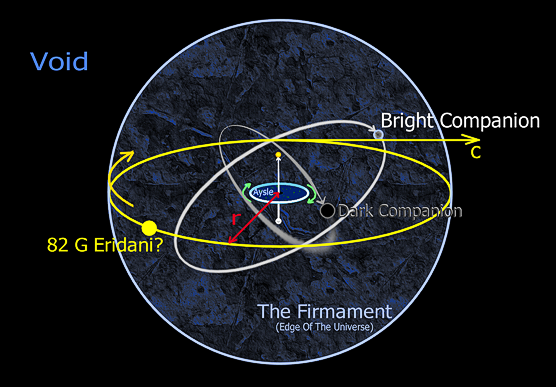
A cosmology based on the premise that 82 Eridani is the limit of the observable universe. Unfortunately, it didn’t work – refer the text.
The absolute fastest that this star can be moving is the speed of light, according to the assumptions made so far.
19.7 light year radius gives circumference 2 × pi × r =
123.78 light years = 1.171049 e+18 meters.
t = dist / speed. Speed of light = 299 792 458 m/s.
1.171049 e+18 / 299 792 458 =
3906199001 seconds =
45210.636 days =
123.78 years.
There are 360° in a circle, so that’s 2.908386° per year.
So, that’s how far 82 Eridani gets around its hypothetical orbit in a year at most.
Now, to convert that into a value for Aysle, if it’s rotating to keep pace, i.e. to hold the most distant star in position:
r = 9000 km
Circumference = 56548.66765 km
Divide by 360 gives 157.08 km/°.
2.908386° in a year =
456.8482 km in a year =
1.2508 km in a day =
0.052116 km/h =
5.2116 meters per hour.
That…doesn’t sound anywhere near fast enough.
I could try scaling to “Aysle-size” – 9000 km / 12713.82 km (the radius of earth) = a x0.7079 factor. That doesn’t seem like it would make enough of a difference.
The problem here is that distance of 19.7 light years.
Perhaps if we scaled it to Aysle’s Sun?
How big is the sun?
Well, the hole is 21 617 km diameter, according to what we worked out earlier.
In the illustrations that I’ve shown, the sun has been about 1/3 of this, so that there’s a full solar radius margin to each side during passage.
That’s a diameter of 7 205.67 km, a radius of 3602.8 km.
But I’ve also got it stretching as much as 50% wider as it passes through the hole, so it’s true radius should be that divided by 150%: 2401.9 km.
Solar Scaling
Sol is 695,700 km in radius. My source didn’t say so, but I know that the Sun is somewhat flattened by its rotation, so I’m assuming that this is the longer radius, the one that aligns with the solar equator and the plane of the ecliptic.
695,700 km / 2401.9 km = 1 / 289.6457.
19.7 light years / 289.6457 = 0.06801 light years
= 4301.02565 AU.
Circumference = 27024 AU = 4.04273 e+12 km.
1000 × 4.04273 e+12 / 2997927458 m/s =
1,348,508 seconds =
374.6 hours =
15.608 days.
4.04273 e+12 km / 360° = 112298 km/degree.
360 / 15.608 days = 23.065° per day =
2990164 km per day.
Bringing that down to Aysle-scale:
Circumference = 56548.66765 km = 360°
1° = 157.08 km, as calculated earlier.
So 23.065° = 23.065 × 157.08 = 3623.0502 km in a day.
= 151 km/hr.
It still takes Aysle 15.608 days to do a full rotation., or longer. As with some of the earlier calculations, I don’t care about the actual numbers; I just want some sort of guideline to follow that shows there is a viable solution.
And 151 km/h? That’s a veritable crawl at Astronomical speeds. I’m not sure that’s even fast enough to create the orbital stability that I was looking for.
Earth has a radius of 12713.82 km. That’s a circumference of 79883.3 km. A point on the equator travels that far in 24 hours – a speed of 3328.47 km / h, not some paltry 151 km/h.
So, I either pluck a number of my hat, or I keep the speed of light as a fundamental limit in Aysle.
Aysle is slightly smaller than Earth – that’s that x0.7079 mentioned earlier. So, applying that to 3328.47 gives 2356.2 km/h as a reasonable equivalent. Call it 2500 km/h.
Gyroscopes spin tens of thousands of times a second or more. Even scaling one up from (say) 9 mm to 9000 km – a 1e+10 conversion – that gives 0.000002 revolutions a second, or 0.1728 revolutions in a day, or 5.8 days a revolution or more. And that’s at a mere 20,000 RPS Divide that number of days by 2.5 to get 50,000 RPS.
Tearing Us Apart, Again
The other question that I had – and I didn’t calculate it at the time – was whether or not the disk itself was strong enough to stand up to all this action. Orbiting at a reasonable speed is one thing, but this is a solid disk.
I suspect that this might be why the designers chose not to have the disk spin in the first place.
If I want to keep the stability of a spinning system, even if that motion is more or less transparent to the inhabitants* (* I’ll get back to this in a moment), then I’ll need a solution to this (assumed) problem.
A second assumed material
The obvious solution is to lace the ‘bones’ of the world with another super-strong material. Some equivalent to D&D’s Adamantine, or Marvel’s Adamantium. I wouldn’t necessarily need a lot of it – the exact quantity would depend on how fast the disk was actually rotating and how strong the material is.
At that point, a number of only marginally-related thoughts began colliding.
- We’ve got ‘veins’ of Down, surely this is ‘Sinew’.
- Muscle fibers are soft and weak until they suddenly aren’t, when they can become rigid and strong enough to break bone.
- Maybe this stuff gets its strength by shunting the strain into the same ‘other place’ that Down hides its extra mass?
- Where exactly is that, anyway?
- What’s the stuff called?
By the time I had sorted all these thoughts, I had a clear concept in mind that addressed all of these questions except the last. As a placeholder, I started calling it “Permiance”, and that name slowly stuck – even though I still don’t consider it perfect as a choice.
Permiance
Permiance runs throughout Aysle, long strands of sinew knotted and woven like spiderweb as thick as a Dwarven Torso. It has the property of binding itself to the rock and earth through which it passes, and in particular it has an affinity for Down. Together, the two constitute a glue that binds the disk of Aysle together despite the forces pulling it apart.
It seems to grow of its own accord; place an off-cut in an unprotected volume of rock or earth and it will double in length every 8-12 weeks.
Permanence is relatively soft and malleable, of similar strength to copper wires 5-15mm in diameter, at least until it is placed under stress or strain, when it becomes harder and stronger than the best steel.
The cobwebby properties continually raise speculation about a spider, or nest of spiders, somewhere that actually spin Permanence as a way of anchoring their nest to this reality. No such spider or nest has ever been found.
This, and all related theories, are commonly referred to as “Spiderealm Speculation”. In terms of workable theories, they account for the known properties of Permiance, but not one word of it has ever been proven.
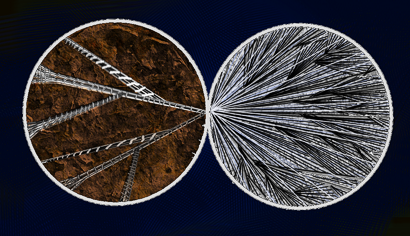
Dwarves are a clever lot, II
Permanence can be removed, one strand at a time, and alloyed with other materials. It seems to imbue those materials with some of its durability, acting to remedy whatever is weakest about the partner material.
Alloyed with gold, silver, or platinum, it produces a variety of same that is brighter in color and as strong as steel. These are known as Gildenfoil, Moonshadow, and Britinum, respectively.
Alloyed with brass, it counters the notable brittleness of that material, restoring to it some of the ductility of the base copper – enough that it can be readily hammered and worked, transformed into thin sheets and panels. These seem to weigh about 3 times what they should, so they tend to be made surprisingly thin, and are frequently employed as a protective coating on armor, shields, and some weapons.
Alloyed with steel, it enhances the strength of the material to create the hardest metal known – but this comes at the price of mass; Ultradium weighs five times the sum of its constituent parts. Armor constructed purely from it has a bluish sheen and looks very impressive, but is usually too heavy to be worn; instead, it is used sparingly as a structural reinforcement. Because of its great strength, less is needed than might be expected, and these reinforcements can be comparatively small and subtle.
Craftsmen working on the latter frequently work with designers to make the reinforcements appear decorative vanities or finery for show rather than the essential component of the net protection offered that they seem to be.
Elves aren’t stupid, either
Elves, on the other hand, also have access (somehow – another state secret) to Permiance, which they name Lumiance. Their craftsmen alloy it with Mercury and precious metals to make various exotic materials.
In general, they focus on mobility, speed, resilience, and lightness rather than outright physical toughness. As a general rule, they do not give the results different names in the human tongue, simply referring to them as “Elven this” or “Elven that”.
Since they refuse to teach their native tongue to outsiders, what they name these things amongst themselves is unknown.
They have also been known to infuse it into the bodies of their domestic creatures, where it enhances power, strength, resilience, stamina, size, and intellect.
Speculation that they have also incorporated it into themselves is given short shrift.
Weather, again
Weather records would actually reveal the rotation. Clouds wouldn’t move straight out from the hole to the rim (if you ignore local wind direction changes), they would appear to follow a spiral pattern.
The reality is that they ARE moving more-or-less straight from hole to rim, but the ground is rotating underneath them.
But it would take a long time to actually realize this, because local winds would dominate the weather patterns; we don’t see much such action on Earth as clouds move from equator, north or south. Instead, local “curling” of the clouds produces self-contained Hurricane systems – and Aysle would therefore have those, too.
How did you get from one side to the other?
We’re slowly cutting through that long list of questions posed at the start of this article.
There are three ways to get from one side of Aysle to the other.
Through The Frozen Wastes
The first is to undertake the perilous journey through the frozen wastelands of the rim; some crevasses and fissures permit passage from one side to the other around the edge of the rim itself.
Because the Dwarves keep secret the existence of their underground subways, this is the only way in which bulk goods can transit.
Despite superficial permanence, the details of this landscape are perpetually changing, and there are no passages that are certain to be open. Every such expedition is a journey of exploration.
Through the boiling seas
How far can a sailing ship get in a few hours – against the wind? Aysle is about 1000 km thick, which means that traversing the boiling seas is a journey of 1570 km, plus the 2000 km or so of boiling seas not actually on the rim, just close to it.
3570 km is a LONG way by ship. There’s nowhere to stop and replenish supplies.
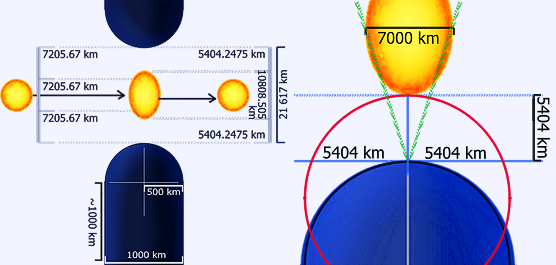
.
Conditions would be at their worst at the midpoint, at Noon. The diagram above depicts this situation and shows that the solar surface would be just 5404 km away.
After I had rough-sketched it, I got curious; just how much of the sky would be filled with the sun?
Well, assuming that it stayed as wide as usual – almost certainly a false assumption – then the sun is about 7000 km wide, and the near side of the ellipse is 5404 km away. However, as you can see from the diagram, aiming for that ‘widest point’ actually gives a slightly smaller value than would truly be the case – there’s a little solar bulge outside those lines. Never mind, assume that this cancels out the error from the earlier assumption.
The circumference of a circle 5404 km in radius, halved, defines the horizon. 2 ×nbsp;pinbsp;×nbsp;r = 33954 km; half of that is 16977 km. 7000 is 41.23% of 16977.
Now that’s a linear measure, not a percentage of the area. I suspect that the correct approach would have been to convert the 7000 km to a radius and get an area, and compare it to the hemispherical surface area, and that squaring the decimal form of 41.23 would be closer to the mark. That yields an estimate of 17% of the sky being sun.
Either way, that’s a lot. Simply being unprotected from the heat would be lethal, one suspects.
Going from ‘day side’ to ‘night side’, the winds would be constantly at your back. You might be able to make 25 or 26 knots* – but the sun’s chasing you a lot faster than that, and as soon as it is overhead, the situation reverses and you face a headwind.
(* speed estimated from memories of the faster speeds in Sid Meyer’s Pirates because all my references are packed away).
25 knots is about 46 km/h. 26 gets you up to 48 km/h. Let’s assume a top speed of 50 km/h. Starting at noon on the side you are departing, you’ll get maybe 8 hours travel before the sun next traverses the hole – 500 km.
That’s 1 / 7.14 of the total distance to cover, or about 14%.
Then you drop anchor and wait for the winds to again be at your back.
Actually, you could probably start a couple of hours before noon, and get an extra 100 km behind you. That’s enough to get you up to 16.8% of the journey in a day.
Six days of hell gets you through to the tropical regions on the far side. A journey not for the faint-hearted.
The Third Method
Option #3 is to contract for passage through the Dwarven Realm. You can expect to be blindfolded and hooded for most of the trip. And probably led on a circuitous route that keeps you well away from anything the Dwarves consider ‘sensitive’ – like Down and Permiance. In a sealed room, at the end of each “day’s” travel, you could unmask and partake of food and refreshment.
It would be a fairly unpleasant trip, probably taking more than 2 weeks, because walking blindfolded and hooded tends to be relatively slow, even with guides to assist.
Conclusion: there ARE no easy ways to get from one side to the other.
Sailing ships – Trade Routes? Favorable Winds?
This is the last of those big questions and brings to an end the conceptual phase of the world creation, a good place to end this article.
Trade winds are, by definition, strong, favorable winds that are reasonably reliable. As a general rule, they oppose the direction of motion of the planetary body because that means that the winds take advantage of that rotation to appear stronger (Clouds and winds never keep pace with the rotation of the planet).
If Upper Aysle rotates clockwise, then trade winds will be anticlockwise relative to the Hole. If it rotates the other way, then clockwise will be the meal-ticket.
Anything more specific than that gets very complicated very fast. Quite frankly, I’d use that truism and generate trade winds wherever I wanted them.
And I did.
Aysle – a realm re-imagined
While the end result bears a superficial resemblance to what’s in the sourcebook, and only contradicts it in places where it won’t show to the casual resident, it is worth appreciating the Sourcebook devotes all of 26 column inches to all of the above – a total of less than a page – plus 3½ pages of maps and diagrams.
This article is around 10K words, about 18 pages of text and 14 diagrams / illustrations, probably adding another 2-3 pages to the total. That much additional content amounts to a complete reinvention, I think.
Because it’s been designed for use prior to the shared-reality universe coming into existence, it functions as a stand-alone adventure location. At the very least, it should make an interesting place to visit!
I also want to emphasize that anything the Dwarves regarded as “Secret” was NOT told to the players in initial briefings; it got ‘discovered’ during play, as revealing the secret was considered less evil (By the Dwarves) than letting events continue to unfold unimpeded. As GMs, you get let in on the magic ‘behind the curtain’.
In the next part of this series, I’ll start on the politics and geography.
But next week, I might start transcribing my even-more-complete rewrite of Orrorsh, the Horror Realm, just for something completely different.
If I’m in a position to post anything at all, that is!
- An Old Aysle To Run Down 1
- The Mists Of Fear Orrorsh Revisited 1
- An Old Aysle To Run Down 2
- The Mists Of Fear Orrorsh Revisited 2





Leave a Reply